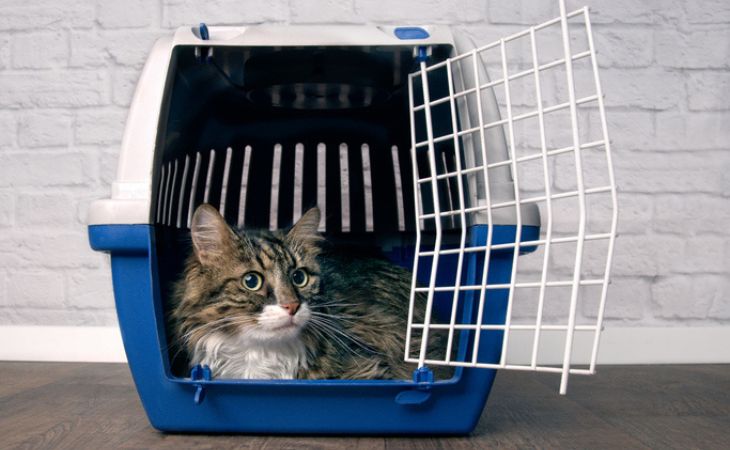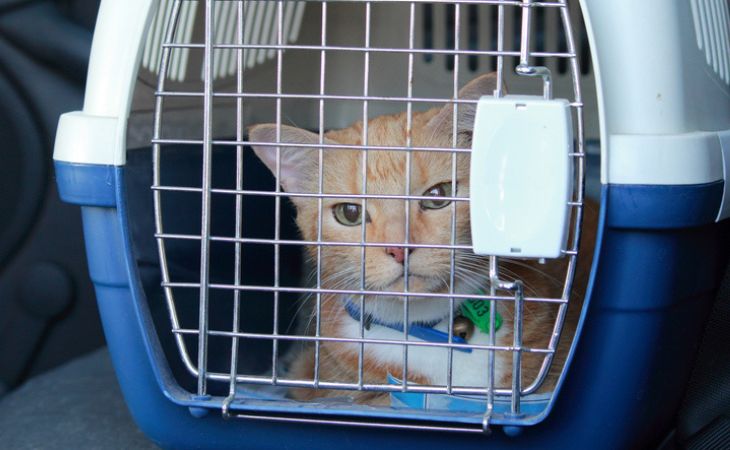It can be difficult to get a cat inside their cat carrier. Cats that are usually calm can find themselves completely transform when they are faced with a cat carrier. With that being said, with the right techniques and a bit of patience, you can transform this stressful moment into a peaceful experience for the both of you. In this article, we’ll go over different types of cat carriers and ways to make the experience more manageable and less stressful.
Choose the right carrier for your cat
Choosing a cat carrier is necessary for the comfort and safety of your cat. Think of their carrier as a protective cocoon. To make sure that they are comfortable, opt for a solid model that is well-ventilated and large enough for them to stand, turn around, and lie down comfortably. You can find models in rigid plastic, in fabric, and with many different types of entrances.
Types of cat carriers
Cat carriers in rigid plastic are robust and easy to clean. This makes them ideal for long car trips or plane trips. Fabric models are lighter and offer a pleasant and comforting experience for short trips or visits to the vet. Cat carrier with multiple entrances are perfect for cats that are more nervous, making it easier to access and less stressful.
Size and comfort
The size is important. A cat carrier needs to be big enough for your cat to stand up in, turn around and lie down easily. A space that is too small can make your cat feel stressed and uncomfortable, while a space that is too big can make your cat feel unsafe. To help them feel more comfortable, add in a soft blanket inside or a soft cushion. This will transform the carrier into a cozy area where they can feel at peace and relax.
Safety and ventilation
Make sure that the carrier is well-ventilated with openings allowing optimal air circulation. The entrances need to be secured to keep your pet from running away during the trip. Also, make sure that the model is easy to transport and that the model has a solid handle. Safety and comfort is necessary for a peaceful trip.
Get your cat used to their cat carrier
To avoid having your cat perceive the cat carrier as the source of stress, you need to get them used to it progressively. Place the carrier into a familiar area, leave it open, and add in comforting items to like a blanket or toy. Use treats to allow for positive associations and make this area feel familiar and safe area.
Progressive exposition
Start by leaving the carrier in an area where your cat passes by a lot, such as the living room. Leave the door open and place treats or their favorite toys inside to encourage them to enter. Repeat this process for several days, even weeks, until your companion feels at ease in the carrier. Patience and gentleness are important to bring an atmosphere of trust.
Create positive associations
Reward your cat with treats, toys, or hugs when they get close to the carrier. You can also feed your cat close to this space or place the food bowl inside so that they associate the area with a pleasant moment. The more positive memories they associate with the carrier, they more they will feel at ease. Every interaction needs to reinforce feelings of safety and well-being.
Techniques to get your cat to enter the carrier
When the time to leave comes, convincing your cat to enter their cat carrier can be delicate. Adopt these gentle and respectful techniques to reduce your cat’s stress. Here are a few useful methods to transform this moment into a peaceful experience.
Gentle approach
Place the cat carrier in a calm area and let your cat get used to the environment. Talk to them gently to reassure them. If necessary, take them delicately into your arms and bring them to the entrance of the carrier, being careful not to be too rough with your movements. Give them time to get used to it before closing the entrance. Gentleness and patience are essential to bring a peaceful atmosphere.
Use pheromones
Synthetic pheromones can be a great help in reducing your furry friend’s anxiety. Spray them into your cat’s carrier a few minutes before you put your cat in. These products, which are available as sprays or diffusers, reproduce the facial pheromones that felines use to mark their territory and feel secure. Create a reassuring environment that envelops your pet in serenity.
Scarf or towel method
For reluctant cats, the scarf or towel method can be useful. Envelop your cat in a soft towel, limiting their movements without hurting them. Then, place them in the carrier very gently. This technique is most often used by vets, allowing them to handle cats stress-free, transforming a potentially anxiety-inducing situation into a moment of calm.

How do I react if my cat refuses to enter the carrier?
If your cat resists entering their cat carrier, stay calm and patient. Never force your cat to go inside as this will only heighten their stress. Instead, try again later with gentle methods and rewards. The key is respect your cat’s pace and transform this into an opportunity to reinforce your bond.
Ensure that your pet is comfortable during the trip
Once your cat is in the carrier, make sure that they are comfortable during the entire trip. Cover the space partially with a light blanket to reduce the amount of external stimuli. Talk to them gently and avoid sudden movements. For long trips, take breaks regularly to make sure that they are doing alright. Let them come out of the carrier at their own pace at the end of the trip, providing them with a reward to reassure them.
Cat carriers: what you should avoid
To succeed in making your cat enter their carrier, some errors should be avoided at all costs. These things can become stressful experiences for them and become a nightmare for your cat.
Using it exclusively for vet visits
Do not use the carrier exclusively for vet visits. Your cat will automatically associate the carrier with an unpleasant experience. To avoid this, use it during other occasions, like for short trips in the cat or even to play in. Integrate it into their daily life so that it becomes a familiar and reassuring object.
Never try to force your cat into the container with force. This can risk traumatizing your cat and making future trips even more difficult. If your cat resists, take the time to calm them or try again later. Use gentle techniques and rewards to encourage your cat to enter the cat carrier on their own, by making this step a moment of gentleness and trust.
You might find this article interesting: Cats and their fear of the vet
Using an unsuitable cat carrier
Avoid transporting your cat in a carrier that is not well-closed or unsuitable for their size. A space that is too small or too large can cause stress and discomfort for your cat. Also, ensure that the carrier is secured, well-ventilated, and sufficiently spacious for your cat to be at ease.
Getting your cat to enter a cat carrier takes patience and gentleness. By choosing a suitable cat carrier, getting them progressively used to it and using respectful technique, you can make the experience less stressful for the both of you. Do not forget that every cat is unique and that adaptation can take time. With perseverance and attention, your companion will come to accept the carrier as part of their daily life.

